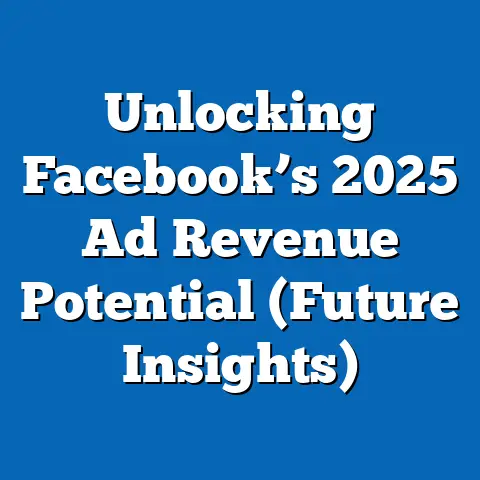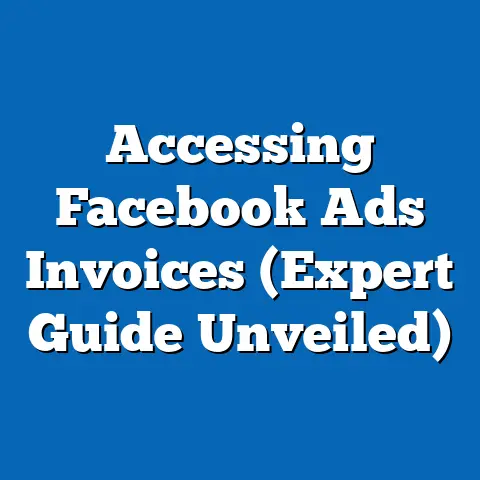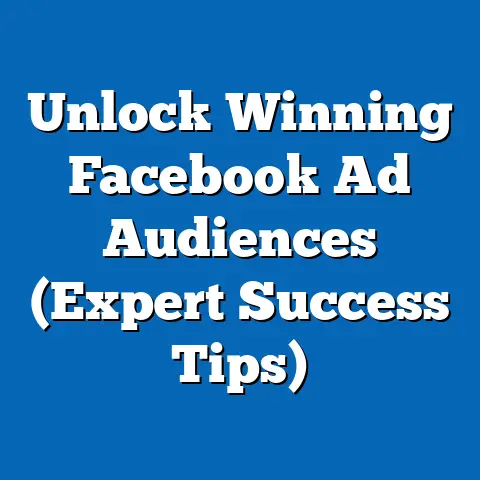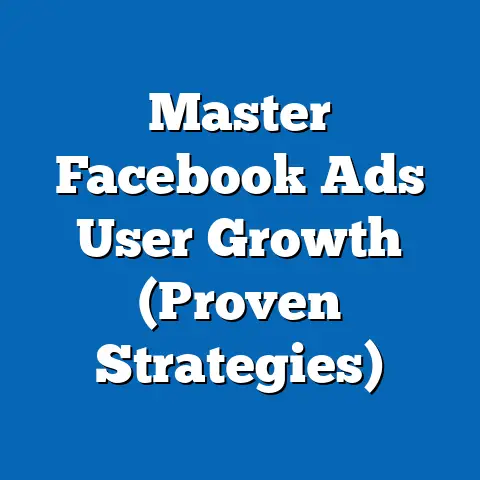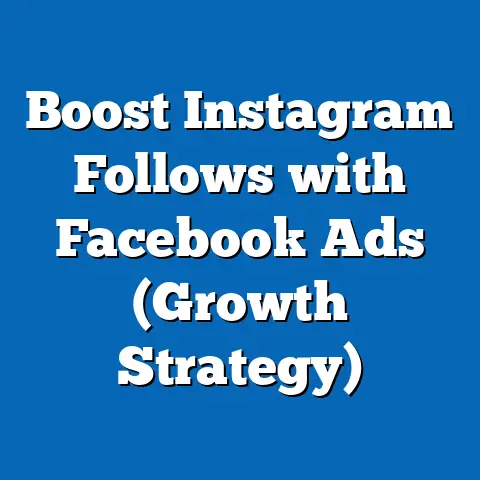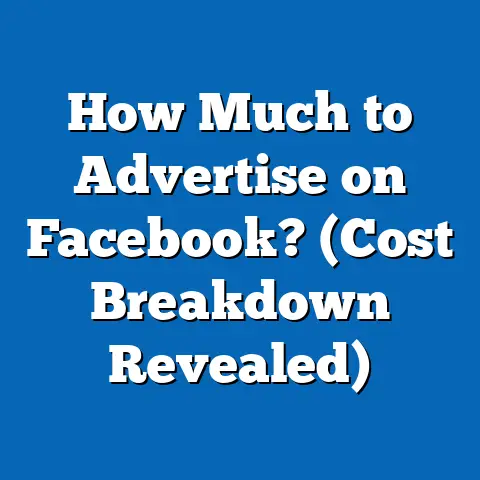Unlock Facebook Ads Savings in 2025 (Expert Strategies)
“Facebook ads don’t work anymore.” “I tried them once, and they were a waste of money.” “Organic reach is dead, so why bother?” These are just a few of the sentiments I’ve heard over the years as a digital marketing specialist. And honestly, I get it. It’s easy to get discouraged when you’re throwing money at a platform and not seeing the results you expect. But let me tell you something: Facebook advertising is far from dead. In fact, it’s more vital than ever for businesses of all sizes to reach their target audience in today’s crowded digital landscape.
Why? Because Facebook still boasts billions of active users, providing an unparalleled opportunity to connect with potential customers. However, the key to success lies in understanding that the Facebook advertising landscape is constantly evolving. What worked last year, or even last month, might not work today. That’s why it’s crucial to stay ahead of the curve and debunk common misconceptions about Facebook ads, which I like to call “durability myths.”
In this guide, I’m going to dive deep into the world of Facebook advertising, debunking these myths and providing you with expert strategies you can use to unlock significant savings on your ad spend in 2025. We’ll explore audience targeting, A/B testing, retargeting, ad formats, budget management, and more. So, buckle up, and let’s get started!
Debunking Durability Myths
One of the biggest challenges in the digital marketing world is the persistence of outdated beliefs. What was once true might no longer hold, but these “durability myths” often linger, preventing marketers from fully embracing new strategies and opportunities. When it comes to Facebook Ads, these myths can be particularly damaging, leading to wasted ad spend and missed opportunities. Let’s tackle some of the most common ones:
Myth 1: Facebook Ads Are Only Effective for Short-Term Campaigns
This is a myth I hear all the time. People think Facebook ads are only good for quick bursts of promotion, like a flash sale or a limited-time offer. While they’re definitely effective for that, limiting them to short-term campaigns is a huge missed opportunity.
I’ve seen countless businesses build sustainable growth through long-term Facebook advertising strategies. Think about it: Facebook allows you to build brand awareness, nurture leads, and cultivate customer loyalty over time.
Why this myth persists:
- Focus on immediate ROI: Many businesses prioritize immediate sales over long-term brand building.
- Lack of patience: It takes time to build a successful long-term campaign.
- Poor tracking and attribution: Difficulty in accurately attributing long-term results to Facebook ads.
The reality:
Facebook ads can be incredibly effective for long-term campaigns focused on:
- Brand awareness: Reaching a wider audience and building brand recognition.
- Lead generation: Collecting leads through targeted campaigns and nurturing them over time.
- Customer retention: Retargeting existing customers with personalized offers and content.
My experience:
I worked with a local bakery that initially only ran Facebook ads for special occasions like Valentine’s Day and Mother’s Day. We convinced them to invest in a long-term campaign focused on building brand awareness and showcasing their delicious creations. Over time, we saw a significant increase in foot traffic to their store and a loyal online following.
Takeaway: Don’t limit Facebook ads to short-term campaigns. Think about how you can use them to build a lasting relationship with your audience.
Myth 2: Once You Find a Winning Ad, You Can Set It and Forget It
Ah, the dream of a “set it and forget it” ad campaign! I wish it were that easy. The truth is, the Facebook advertising landscape is constantly changing. What works today might not work tomorrow.
I’ve seen so many businesses launch a successful ad, watch the results soar, and then assume it will continue performing that way indefinitely. But then, the dreaded performance dip happens. Why? Because audiences get ad fatigue, competitors copy your strategy, and Facebook’s algorithm evolves.
Why this myth persists:
- Initial success: The initial positive results create a false sense of security.
- Lack of time and resources: Businesses often lack the time or resources to continuously monitor and optimize their campaigns.
- Fear of change: Some marketers are hesitant to make changes to a campaign that’s already performing well.
The reality:
Successful Facebook advertising requires constant monitoring, testing, and optimization. You need to:
- Track your metrics: Regularly monitor your key performance indicators (KPIs) like click-through rate (CTR), cost-per-click (CPC), and conversion rate.
- A/B test everything: Continuously test different ad creatives, headlines, and targeting options.
- Stay updated on algorithm changes: Keep up with the latest news and updates from Facebook to understand how the algorithm is evolving.
My experience:
I once managed a campaign for an e-commerce store that was generating amazing results. We had a winning ad that was consistently driving sales. However, after a few months, the performance started to decline. We realized that our target audience was experiencing ad fatigue. We refreshed the creative, tweaked the copy, and saw an immediate improvement in performance.
Takeaway: Don’t fall into the trap of “set it and forget it.” Continuously monitor, test, and optimize your campaigns to stay ahead of the curve.
Myth 3: Facebook Ads Are Saturated and No Longer Effective
This is a common complaint I hear, especially from smaller businesses: “Facebook is too crowded. My ads will just get lost in the noise.” While it’s true that the platform is competitive, it’s far from saturated.
I firmly believe that with the right strategy and creative execution, you can still achieve significant results with Facebook ads, even in a crowded marketplace. The key is to stand out from the competition and connect with your audience on a deeper level.
Why this myth persists:
- Increased competition: The growing number of businesses advertising on Facebook.
- Algorithm changes: Changes to the algorithm that make it harder to reach your target audience organically.
- Ad fatigue: Audiences becoming desensitized to generic advertising.
The reality:
Facebook ads can still be incredibly effective if you:
- Target the right audience: Use Facebook’s advanced targeting options to reach the most relevant users.
- Create compelling content: Develop high-quality, engaging content that resonates with your audience.
- Offer value: Provide real value to your audience through your ads, whether it’s information, entertainment, or a solution to their problems.
My experience:
I worked with a small local coffee shop that was struggling to compete with larger chains. We created a Facebook ad campaign focused on showcasing their unique coffee blends and highlighting their commitment to the community. We targeted local residents who were interested in coffee and supporting local businesses. The campaign was a huge success, driving significant foot traffic to their shop and building a loyal customer base.
Takeaway: Don’t let the competition discourage you. With the right strategy and creative execution, you can still achieve significant results with Facebook ads.
Understanding the Facebook Ads Landscape in 2025
Looking ahead to 2025, it’s crucial to anticipate the changes that will shape the Facebook advertising landscape. The platform is constantly evolving, and staying informed about these changes is essential for maximizing your advertising effectiveness.
Key trends to watch:
- Increased focus on privacy: With growing concerns about data privacy, Facebook is likely to continue implementing measures to protect user information. This could impact targeting options and require advertisers to be more transparent about their data collection practices.
- Rise of AI and automation: Artificial intelligence (AI) and automation will play an increasingly important role in Facebook advertising. AI-powered tools will help advertisers optimize their campaigns, personalize their ads, and automate repetitive tasks.
- Emphasis on video content: Video content will continue to dominate the Facebook feed. Advertisers will need to create engaging video ads that capture attention and tell a compelling story.
- Growth of mobile advertising: Mobile devices will remain the primary way people access Facebook. Advertisers will need to optimize their ads for mobile viewing and ensure they are mobile-friendly.
- Integration of augmented reality (AR): AR technology is likely to become more integrated into Facebook advertising. Advertisers will be able to create immersive AR experiences that allow users to interact with their products and services in new ways.
Regulatory changes and privacy concerns:
Regulatory changes and privacy concerns will continue to be a major factor in the Facebook advertising landscape. Advertisers will need to comply with regulations like the General Data Protection Regulation (GDPR) and the California Consumer Privacy Act (CCPA). They will also need to be transparent about their data collection practices and give users more control over their data.
Staying informed:
To stay informed about these changes, I recommend:
- Following the Facebook Business blog: This blog provides updates on new features, best practices, and industry trends.
- Attending industry conferences and webinars: These events provide valuable insights from industry experts.
- Networking with other marketers: Sharing knowledge and experiences with other marketers can help you stay ahead of the curve.
- Experimenting with new features and strategies: Don’t be afraid to try new things and see what works best for your business.
Takeaway: Stay informed about the changing Facebook advertising landscape and adapt your strategies accordingly.
Expert Strategies for Unlocking Savings in Facebook Ads
Now that we’ve debunked some common myths and discussed the future of Facebook advertising, let’s dive into some expert strategies you can use to unlock significant savings on your ad spend.
Strategy 1: Audience Targeting and Segmentation
Targeting the right audience is the foundation of any successful Facebook advertising campaign. If you’re showing your ads to people who aren’t interested in your products or services, you’re just wasting money.
Facebook offers a wide range of targeting options, including:
- Demographics: Age, gender, location, education, income, etc.
- Interests: Hobbies, activities, pages they like, etc.
- Behaviors: Purchase history, device usage, travel habits, etc.
- Custom Audiences: Lists of existing customers or website visitors.
- Lookalike Audiences: People who are similar to your existing customers.
My experience:
I worked with an online clothing retailer that was struggling to generate sales. We analyzed their customer data and discovered that their ideal customer was a woman aged 25-35 who was interested in fashion, travel, and healthy living. We created a Facebook ad campaign targeting this specific audience and saw a significant increase in sales.
Best practices:
- Start with a broad audience and then narrow it down: This allows you to test different targeting options and see what works best.
- Use Custom Audiences to retarget existing customers: This is a highly effective way to drive sales and increase customer loyalty.
- Create Lookalike Audiences to reach new customers: This allows you to reach people who are similar to your best customers.
- Segment your audience based on their interests and behaviors: This allows you to create more personalized ads that resonate with each segment.
Takeaway: Precise targeting leads to better conversion rates and lower cost-per-click (CPC).
Strategy 2: A/B Testing for Cost Efficiency
A/B testing, also known as split testing, is the process of comparing two versions of an ad to see which one performs better. This is an essential strategy for optimizing your ad campaigns and maximizing your return on investment (ROI).
What to A/B test:
- Headlines: Try different headlines to see which one grabs attention and encourages clicks.
- Images: Test different images to see which one resonates best with your audience.
- Copy: Experiment with different ad copy to see which one drives the most conversions.
- Call-to-action (CTA): Try different CTAs to see which one encourages the most people to take action.
- Targeting: Test different targeting options to see which one reaches the most relevant audience.
My experience:
I managed a campaign for a software company that was struggling to generate leads. We A/B tested two different headlines: “Free Trial” vs. “Get Started Today.” The “Get Started Today” headline generated significantly more leads.
Best practices:
- Test one variable at a time: This allows you to isolate the impact of each variable.
- Use a control group: This allows you to compare the results of your test group to a baseline.
- Run your tests for a sufficient amount of time: This ensures that you have enough data to draw meaningful conclusions.
- Analyze your results and make data-driven decisions: Use the data from your A/B tests to optimize your ad campaigns.
Takeaway: A/B testing helps you determine what resonates best with your audience, leading to more efficient ad spend.
Strategy 3: Leveraging Facebook Pixel for Retargeting
The Facebook Pixel is a small piece of code that you install on your website. It allows you to track user behavior and retarget visitors with relevant ads.
How it works:
When someone visits your website, the Facebook Pixel tracks their actions, such as:
- Page views: Which pages they visited.
- Add to cart: When they added an item to their cart.
- Purchase: When they made a purchase.
You can then use this data to create retargeting campaigns that show ads to people who have previously visited your website.
My experience:
I worked with an e-commerce store that was experiencing a high cart abandonment rate. We implemented a retargeting campaign that showed ads to people who had added items to their cart but didn’t complete the purchase. The campaign was highly effective, recovering a significant percentage of abandoned carts.
Best practices:
- Install the Facebook Pixel on your website: This is the first step to using retargeting.
- Create custom audiences based on website activity: This allows you to target specific groups of visitors with relevant ads.
- Show ads with personalized offers: Offer discounts or free shipping to encourage people to complete their purchase.
- Exclude people who have already purchased: This prevents you from showing ads to people who have already converted.
Takeaway: Retargeting visitors with the Facebook Pixel leads to higher conversion rates and reduced ad costs.
Strategy 4: Exploring Ad Formats and Innovative Content
Facebook offers a variety of ad formats, each with its own strengths and weaknesses. Choosing the right ad format for your campaign can significantly impact your results.
Popular ad formats:
- Image ads: Simple and effective for showcasing products or services.
- Video ads: Highly engaging and ideal for telling stories.
- Carousel ads: Allow you to showcase multiple products or services in a single ad.
- Slideshow ads: Create a visually appealing experience using a series of images or videos.
- Collection ads: Showcase a catalog of products in a visually immersive format.
- Instant Experience ads: Create a full-screen, interactive experience that loads instantly.
My experience:
I worked with a travel agency that was promoting a new tour package. We created a carousel ad that showcased the different destinations included in the tour. The carousel ad was highly effective, generating a significant number of leads and bookings.
Best practices:
- Choose the right ad format for your campaign goals: Consider what you want to achieve with your campaign and choose an ad format that aligns with your goals.
- Use high-quality visuals: Your ads should be visually appealing and attention-grabbing.
- Write compelling copy: Your ad copy should be clear, concise, and persuasive.
- Include a clear call-to-action: Tell people what you want them to do.
- Experiment with different ad formats: Test different ad formats to see which one performs best for your business.
Takeaway: High-quality, eye-catching content drives engagement and reduces cost-per-impression (CPI).
Strategy 5: Budget Management and Bid Strategies
Setting a realistic budget and choosing the right bidding strategy are crucial for maximizing your ROI on Facebook ads.
Budget management:
- Set a daily or lifetime budget: A daily budget allows you to spend a certain amount each day, while a lifetime budget allows you to spend a certain amount over the course of the campaign.
- Adjust your budget based on performance: If your campaign is performing well, you can increase your budget to reach more people. If it’s not performing well, you can decrease your budget to avoid wasting money.
- Monitor your ad spend closely: Keep an eye on your ad spend to make sure you’re not overspending.
Bidding strategies:
- Automatic bidding: Facebook automatically sets your bids to get the most results for your budget.
- Manual bidding: You set your own bids based on your campaign goals.
My experience:
I worked with a startup that had a limited budget for Facebook advertising. We started with a small daily budget and used automatic bidding. As the campaign performed well, we gradually increased the budget and switched to manual bidding to gain more control over our costs.
Best practices:
- Start with a small budget and gradually increase it: This allows you to test your campaign and optimize it before spending a lot of money.
- Choose the right bidding strategy for your campaign goals: If you’re focused on getting the most results for your budget, use automatic bidding. If you want more control over your costs, use manual bidding.
- Monitor your bids closely: Keep an eye on your bids to make sure you’re not overpaying for clicks or impressions.
Takeaway: Choosing the right bidding strategy based on campaign goals is key to effective budget management.
Case Studies of Successful Facebook Ads Campaigns
Let’s take a look at a couple of real-world examples of businesses that have successfully implemented these expert strategies to unlock savings on Facebook Ads:
Case Study 1: Local Restaurant
Challenge: A local restaurant was struggling to attract new customers.
Strategy:
- Audience Targeting: Targeted local residents interested in dining out, specific cuisines, and local events.
- A/B Testing: Tested different ad creatives featuring menu items and special promotions.
- Retargeting: Retargeted website visitors with ads highlighting daily specials and online ordering options.
- Ad Formats: Used a combination of image ads and video ads showcasing the restaurant’s atmosphere and food.
Results:
- Increased website traffic by 40%.
- Increased online orders by 25%.
- Reduced cost-per-acquisition (CPA) by 15%.
Lessons Learned:
- Precise targeting is essential for reaching the right audience.
- A/B testing helps optimize ad creatives for maximum impact.
- Retargeting can drive conversions from website visitors.
- Using a variety of ad formats keeps campaigns fresh and engaging.
Case Study 2: E-commerce Business
Challenge: An e-commerce business was experiencing a high cart abandonment rate.
Strategy:
- Audience Targeting: Targeted customers based on their interests and purchase history.
- Retargeting: Retargeted website visitors who had added items to their cart but didn’t complete the purchase with ads offering a discount.
- Ad Formats: Used carousel ads to showcase the products that had been added to the cart.
Results:
- Reduced cart abandonment rate by 20%.
- Increased sales by 15%.
- Improved customer retention.
Lessons Learned:
- Retargeting is highly effective for recovering abandoned carts.
- Offering a discount can incentivize customers to complete their purchase.
- Carousel ads are ideal for showcasing multiple products.
Conclusion
Facebook advertising is a powerful tool that can help businesses of all sizes reach their target audience and achieve their marketing goals. However, it’s important to understand that the Facebook advertising landscape is constantly evolving. By debunking common myths and implementing the expert strategies outlined in this guide, you can unlock significant savings on your ad spend and maximize your ROI in 2025.
Remember to stay informed about the latest trends and algorithm changes, continuously monitor and optimize your campaigns, and never be afraid to experiment with new features and strategies. A proactive and informed approach is key to success in the dynamic world of Facebook advertising.
Call to Action
I’d love to hear about your experiences with Facebook ads. What challenges have you faced? What strategies have worked well for you? Share your thoughts and insights in the comments below! And if you found this guide helpful, be sure to subscribe for more insights and updates on digital marketing trends and strategies.

